
Bioelectricity
Scope & Guideline
Harnessing Bioelectric Phenomena for Health Advancements
Introduction
Aims and Scopes
- Bioelectric Mechanisms in Cellular Processes:
Research on how electric fields influence cellular behavior, including cell signaling, migration, and membrane dynamics. - Application of Bioelectricity in Therapeutics:
Exploration of therapeutic applications of bioelectricity, including electroporation, electrochemotherapy, and stimulation techniques in oncology and regenerative medicine. - Interdisciplinary Approaches to Bioelectricity:
Integration of concepts from biology, physics, and engineering to develop novel technologies and treatments based on bioelectric principles. - Role of Ion Channels and Membrane Potentials:
Investigation into the functioning of ion channels and their role in maintaining membrane potentials, cellular communication, and various physiological processes. - Bioelectricity in Development and Regeneration:
Studies focusing on how bioelectric signals guide developmental processes and tissue regeneration across different organisms. - Environmental and Ecological Aspects of Bioelectricity:
Research on bioelectric phenomena in plants, microbial communities, and their environmental interactions, highlighting the ecological significance of bioelectric signals.
Trending and Emerging
- Nano-Pulse Stimulation Technologies:
A growing body of research focuses on the application of nano-pulse stimulation in various therapeutic contexts, particularly in oncology, indicating a trend towards minimally invasive techniques with significant therapeutic potential. - Machine Learning in Bioelectricity:
The integration of machine learning approaches to analyze bioelectric data and enhance detection methods is on the rise, showcasing the intersection of computational methods with experimental biology. - Electroporation in Cancer Therapy:
Increasing attention is being paid to the role of electroporation in cancer treatment, with studies demonstrating its effectiveness in enhancing drug delivery and immune responses. - Bioelectricity in Regenerative Medicine:
Research focusing on the role of bioelectric signals in tissue regeneration and repair is expanding, reflecting a growing interest in harnessing these processes for therapeutic applications. - Interdisciplinary Collaborations:
There is a notable increase in interdisciplinary research that combines biology, engineering, and computational modeling, indicating a trend towards collaborative approaches in addressing complex bioelectric phenomena.
Declining or Waning
- General Electrophysiology:
Broad topics in electrophysiology that do not directly relate to bioelectric applications are becoming less prominent, as the journal narrows its focus to more specialized applications and technologies. - Basic Research on Ion Channels:
While ion channels remain a critical area, the emphasis is shifting from general studies to their specific applications in disease treatment and bioengineering, leading to fewer publications on basic ion channel behavior. - Historical Perspectives on Bioelectricity:
Papers focusing on historical reviews or general overviews of bioelectricity are declining, as the journal prioritizes novel research findings and innovative applications over retrospective analyses. - Plant Bioelectricity:
Research specifically targeting plant bioelectricity is appearing less frequently, possibly due to a shift towards more clinically relevant applications in human health and disease. - Non-therapeutic Applications of Bioelectricity:
Topics discussing bioelectricity in non-therapeutic contexts, such as basic science without direct application, are declining as the focus shifts towards impactful therapeutic developments.
Similar Journals
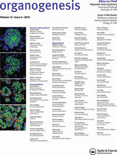
Organogenesis
Transforming Understanding in Regenerative Medicine.Organogenesis is a leading journal published by Taylor & Francis Inc, dedicated to advancing the field of developmental biology and regenerative medicine. With an ISSN of 1547-6278 and E-ISSN 1555-8592, this journal spans an extensive research scope that includes embryology, transplantation, and biomedical engineering, distinguishing itself as a crucial platform for researchers and practitioners alike. Its impact is reflected in its performance across various categories in 2023, earning Q3 rankings in Biomedical Engineering and Embryology, Q4 in Developmental Biology, and Q2 in Transplantation, showcasing its reputable standing among peer journals. Moreover, with Scopus rankings indicating strong positioning in the fields of medicine and biochemistry, Organogenesis is essential for those looking to publish or stay updated on pioneering research. The journal facilitates rigorous peer-review and offers a forum for disseminating innovative findings, making it an invaluable resource for academics, professionals, and students committed to understanding the complexities of organism development.

Cell Regeneration
Fostering Collaboration in the Realm of Cell RegenerationCell Regeneration, published by SPRINGERNATURE, stands at the forefront of biological research, focusing on the dynamic field of cellular development and regenerative biology. Since its establishment in 2012, this journal has embraced an Open Access model, facilitating widespread dissemination of key findings and fostering collaboration among researchers in the Netherlands and beyond. With an impact factor underscoring its significance, Cell Regeneration is positioned in the Q2 category in both Cell Biology and Developmental Biology as of 2023, ranked #32 out of 82 and #170 out of 285 in relevant Scopus peer fields. The journal encompasses a broad spectrum of research that advances our understanding of cellular processes, offering vital insights into regenerative mechanisms and their applications in therapies. This robust platform not only serves as a valuable resource for researchers, professionals, and students but also encourages scholarly dialogue and innovation in the fast-evolving landscape of cell biology.

EUROPEAN BIOPHYSICS JOURNAL WITH BIOPHYSICS LETTERS
Exploring the Molecular Mysteries of LifeEuropean Biophysics Journal with Biophysics Letters is a leading academic journal published by Springer that focuses on innovative research in the field of biophysics. Founded in 1984, it has consistently provided a platform for the dissemination of high-quality scientific findings, bridging the gap between biophysics and its applications in medicine and related fields. With an ISSN of 0175-7571 and an E-ISSN of 1432-1017, this journal has established itself as a Q2-rated publication in both Biophysics and Miscellaneous Medicine, highlighting its influential role in advancing knowledge and fostering collaboration among researchers. The journal features original research articles, reviews, and technical notes that contribute significantly to our understanding of biological systems at a molecular level. Although it does not offer an open-access model, the journal remains committed to promoting scholarly communication and enhancing the visibility of biophysical research globally. By maintaining a Scopus Rank of #74/152 within the category of Biochemistry, Genetics and Molecular Biology, it positions itself as an essential resource for professionals, researchers, and students aiming to stay at the forefront of biophysical science.

Materials Today Bio
Advancing the frontier of bioengineering and biomaterials.Materials Today Bio, published by Elsevier, is an esteemed open-access journal dedicated to advancing the fields of bioengineering, biomaterials, and biomedical engineering. Since its inception in 2019, this journal has quickly made a name for itself, currently ranked Q1 in multiple categories including Bioengineering, Biomaterials, and Biotechnology, reflecting its exceptional quality and relevance in the rapidly evolving landscape of bio-related sciences. With an impressive Scopus ranking positioning it in the top 25% of its categories, Materials Today Bio provides a vital platform for researchers and professionals to share cutting-edge discoveries and innovative applications that bridge the gap between materials science and biological studies. Accessible to a global audience, this journal not only fosters collaboration among the scientific community but also aims to highlight significant advancements in cell and molecular biology, making it an indispensable resource for students and seasoned experts alike. The journal's commitment to open access since 2019 underscores its dedication to disseminating knowledge widely, ensuring that crucial findings reach those who can benefit from them the most.
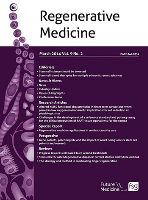
Regenerative Medicine
Advancing the Frontiers of HealingRegenerative Medicine, published by Taylor & Francis Ltd, is a pivotal journal within the field of biomedical research, focusing on the innovative advances in regenerative and restored functions in human health. With an ISSN of 1746-0751 and an E-ISSN of 1746-076X, this esteemed journal boasts a commendable impact factor within its categories, notably holding the Q2 status in Embryology and Q3 in Biomedical Engineering as of 2023. Covering a broad spectrum of topics from stem cell research to tissue engineering, it serves as a crucial platform for interdisciplinary collaboration among researchers, professionals, and students dedicated to the regeneration of tissues and organs. Given its comprehensive scope from 2006 to 2024, the journal continues to attract high-quality manuscripts that advance the frontiers of knowledge in regenerative medicine. Researchers and practitioners alike are encouraged to engage with the latest findings and methodologies disseminated in this vital publication.

Frontiers in Cell and Developmental Biology
Unlocking the mysteries of life at the cellular level.Frontiers in Cell and Developmental Biology is a leading open-access journal published by FRONTIERS MEDIA SA, dedicated to advancing the understanding of fundamental biological processes at the cellular and developmental levels. Since its inception in 2013, the journal has positioned itself as a cornerstone of research in its field, achieving esteemed Q1 quartile rankings in both Cell Biology and Developmental Biology for 2023. With a robust Scopus ranking of #13 out of 82 in Developmental Biology and #67 out of 285 in Cell Biology, it represents a vital platform for innovative research and scholarly discourse. The journal provides a comprehensive and accessible avenue for researchers, professionals, and students alike to share high-quality findings and insights into cellular mechanisms and developmental processes, fostering collaboration and knowledge exchange in the global scientific community. Based in Lausanne, Switzerland, Frontiers in Cell and Developmental Biology is committed to open science, ensuring that all articles are freely accessible to the public, thereby broadening the impact of research in the biological sciences.
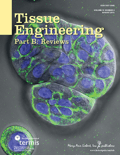
Tissue Engineering Part B-Reviews
Unveiling Cutting-edge Research in Tissue Engineering.Tissue Engineering Part B-Reviews is a premier academic journal published by MARY ANN LIEBERT, INC, focusing on the interdisciplinary field of tissue engineering and regenerative medicine. With an impressive impact factor that places it in the Q1 category across multiple relevant fields—including Biochemistry, Bioengineering, Biomaterials, and Biomedical Engineering—this journal provides a vital platform for researchers and professionals to disseminate cutting-edge findings and comprehensive reviews. Covering a vast scope from 2008 to 2024, the journal is committed to advancing knowledge in the application of engineering principles to biological tissues, making it an indispensable resource for those at the forefront of biomedical innovation. While the journal does not currently offer open access options, its rigorous peer review process ensures high-quality contributions that are essential for academic and practical advancements. The journal's rankings in Scopus reflect its significance, catering to a diverse audience of students, researchers, and practitioners seeking the latest insights in this dynamic field.
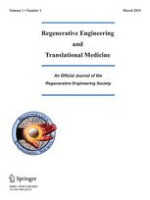
Regenerative Engineering and Translational Medicine
Unveiling New Horizons in Cell Biology and EngineeringRegenerative Engineering and Translational Medicine is an esteemed academic journal published by Springer Heidelberg, focusing on the interdisciplinary fields of biomaterials, biomedical engineering, and cell biology. With an ISSN of 2364-4133 and an E-ISSN of 2364-4141, the journal has carved a niche for itself since its inception in 2015, showcasing cutting-edge research that bridges the gap between scientific findings and practical applications in regenerative medicine. As a recognized platform in its field, it is currently positioned within Q3 quartiles in biomaterials, biomedical engineering, and medicine (miscellaneous), with a Scopus ranking that reflects its growing influence among peers. The journal aims to disseminate high-quality, peer-reviewed articles that highlight advancements in regenerative engineering, further advancing both theoretical and applied research. Scholars and practitioners seeking to stay at the forefront of the ever-evolving landscape of regenerative health solutions will find invaluable insights and innovations within these pages. Join a community of leading thinkers and explore the journal's comprehensive research contributions, which are crucial for fostering partnerships between academia and industry in the quest for transformative medical solutions.
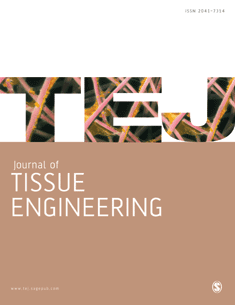
Journal of Tissue Engineering
Exploring Innovations in Biomaterials and BeyondThe Journal of Tissue Engineering, published by SAGE Publications Inc., stands at the forefront of innovation in the interdisciplinary fields of biomaterials and biomedical engineering. Established as an open access journal since 2010, it has quickly ascended to a leading position, as evidenced by its impressive rankings in 2023: Q1 in Biomaterials, Q1 in Biomedical Engineering, and Q1 in Medicine (miscellaneous). With a current impact factor that underscores its academic influence, this journal provides a vital platform for researchers, professionals, and students to share groundbreaking discoveries and advancements in tissue engineering and regenerative medicine. Located in the United Kingdom, the journal fosters a global dialogue with its robust publications and rigorous peer-review process, contributing significantly to the enhancement and understanding of complex biological systems. Join the esteemed community of thought leaders and innovators shaping the future of healthcare through the Journal of Tissue Engineering.

JOURNAL OF BIOENERGETICS AND BIOMEMBRANES
Illuminating the Pathways of Cellular EnergyJOURNAL OF BIOENERGETICS AND BIOMEMBRANES, published by SPRINGER/PLENUM PUBLISHERS, is a leading journal dedicated to the study of bioenergetics and biomembranes, covering essential topics such as cellular energy transformation and membrane dynamics. Since its inception in 1976, the journal has developed a robust reputation within the scientific community, currently holding a Q3 ranking in Cell Biology and a Q2 ranking in Physiology for 2023. Boasting a prestigious Scopus Rank in both Biochemistry and Physiology, it serves as a crucial platform for disseminating pioneering research findings. With its commitment to quality and innovation, the journal plays a significant role in advancing our understanding of the fundamental processes that underlie life at the cellular level. Although it does not offer open access options, the journal remains accessible through universities and research institutions, ensuring that vital research is widely shared among scholars, professionals, and students alike. The JOURNAL OF BIOENERGETICS AND BIOMEMBRANES is essential for anyone seeking to contribute to or stay informed about developments in this dynamic field.